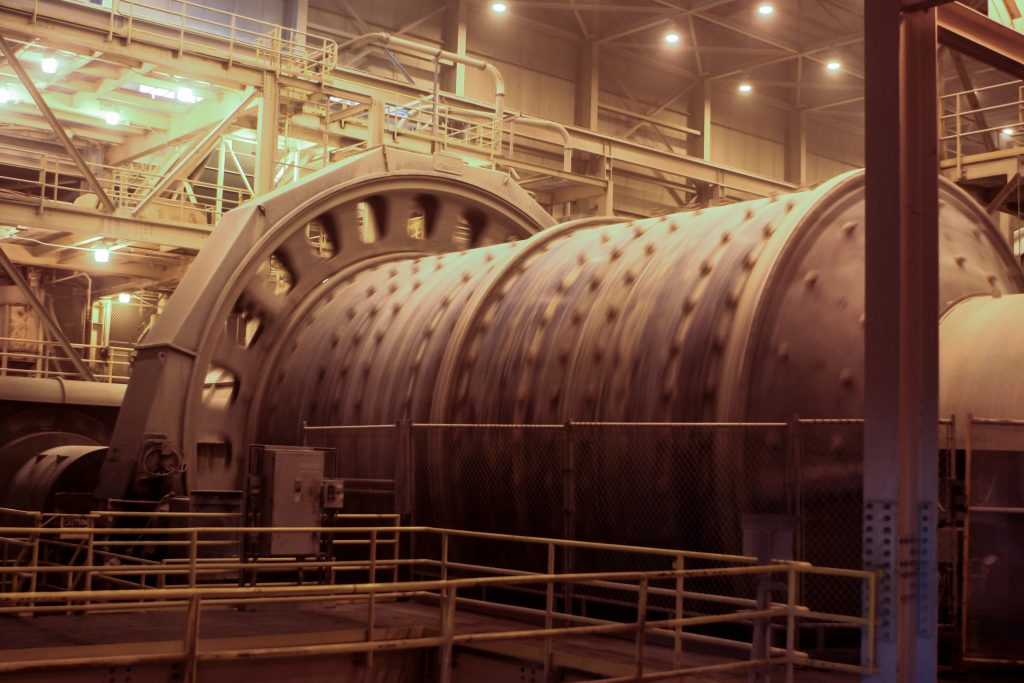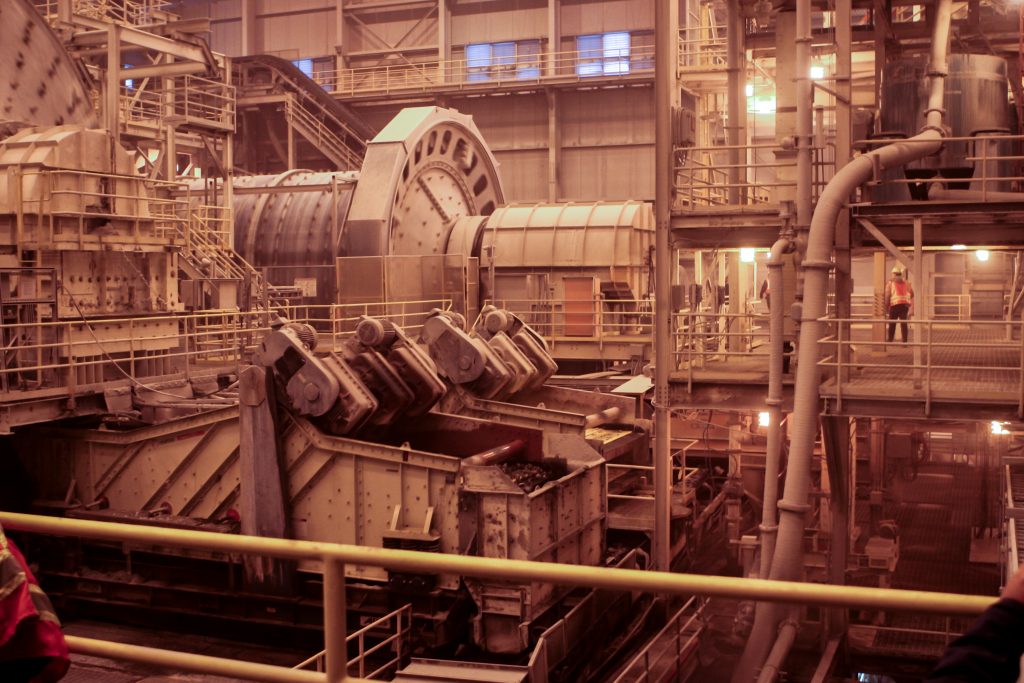Contents
Objectives
Upon completion of this lesson students should be able to:
- Explain crusher blockage.
- Summarize crusher maintenance.
- Identify general hazards associated with crushers.
Reading & Lecture
The hazards involved with blockages, dangerous moving parts, objects being ejected from crushers and mills and maintenance tasks all need careful management.
Common Hazards in Grinding Circuit
- Torque converters and couplers
- High pressure of oil
- Electric motor
- Water
- High voltage
- Rotating big drums
- Moving machine parts
- Drive gear
Crusher Blockage
- Clearing blocked jaw crushers can be very hazardous and many plant operators have been killed carrying out this task. Blockage incidents can be greatly reduced by supplying rock that is properly sized to match the primary jaw opening. Prevention of oversize in feed material starts at the face with good fragmentation. Removal of oversize material before delivery to the plant and vigilant control of the crusher feeder will make blockages unlikely.
- Remotely controlled methods are recommended for clearing blocked jaw crushers and if manual methods are to be used a comprehensive assessment of the risks is essential. Rules and safe operating procedures should be established for each task and the operators must be properly trained before being authorized to do this work.
- The practice of using of steel bars to lever rocks in blocked crushers has a high accident rate. Hand and back injuries are common but far more serious harm can occur, particularly if an attempt is made to bar material in a running crusher. Bars should never be used on or near a crusher while it is running. Before any barring begins, the plant should be shut down and locked out.
- Unstable material that could fall causing injury must be cleared away or made safe. The operator should select a bar that is a suitable length for the job and be positioned so as not lose balance. Appropriate personal protective equipment must be used, including fall protection if necessary. Use of steel wedges to free blocked jaw crushers also has a high potential for serious harm. Wedges can be ejected from a crushing chamber with considerable force and movement of the material in the chamber can also suddenly drag them down. If wedging is done by hand the tool must have a quick easy-release handle. Only mild steel wedges are suitable and while bucket teeth may be well shaped but they should never be used in crushers.
- Hooks should not be used in a running crusher unless remotely controlled. Before spalling to break up large rocks inspect the hammer and other equipment to be used and ensure it is in safe working order. Use eye, face and hand protection, and if necessary arm and leg protection as well. Clearing blockages in large jaw crushers by remote controlled hydraulic equipment is recommended but note that this may introduce other hazards such as flying rock chips from impact hammers.
Crusher and Mill Maintenance
- Hazards during maintenance are many including falls, being caught in moving equipment and being crushed by heavy components. Recently an overseas operator with more than 4 years experience was killed when a heavy jaw crusher liner plate dislodged as he was attempting to secure it. This type of accident calls attention to the need to have safe maintenance procedures for all tasks.
- Maintenance procedures must take account of manufacturer’s instructions and safety warnings. When performing maintenance inside large jaw crushers a specially designed platform may be inserted into the jaws to prevent movement and to provide a secure place to work from. Before lifting ensure the device is suitable for the job, and the load is securely attached with all personnel clear of the danger area. Following placement make sure the load will not accidentally fall or shift before detaching the lifting device.
Electricity
- Electrical work can only be done by qualified electricians but operators should make regular visual checks to ensure that equipment is in a safe condition and that cables remain properly supported and well protected.
- Fires are often caused by faulty electrical equipment and suitable fire extinguishing capability should be readily available. Electrical installation rooms must be kept dry and clear of combustible materials and must not be used for general storage. Isolating transformers or earth leakage protection should be used for work with electrical hand tools.
Mill Safety Maintenance Procedure
- Planning
- Selecting and briefing the crew
- Issuing Safe Work Permit
- Barricading
- Locking out electrical power
- Removing the hatches
- Safeguarding access to the mill
- Safeguarding welding and cutting
- Performing other maintenance work
- Reinstalling the hatch
- Cleaning up
Planning
Planning is needed to ensure close cooperation and coordination between the production and maintenance departments and maintain the safety and efficiency of the task attempt.
Selecting and briefing the crew
Maintenance crew to be selected to perform the job during shutdown and parts and supplies needed for the job must be readily available.
Safe Work Permit
SMP is needed to all jobs to be performed in confined spaces. The checklist includes questions such as these:
- Hot work
- Qualified workers or contractors
- Workers/contractors all briefed
- Atmosphere testing
- Emergency rescue
- Safety equipment
- Personal protective equipment
Barricading
Barricading the area around the mill and put signs forbidding entry upon unauthorized personnel
Locking out and tag out
In terms of safety the electrical lockout of the machinery is the single most important step in this procedure.
After the power disconnected, the circuit is tested.
Puts personal locks on the tongs of power. This is to ensure that mill cannot be re-energized until the maintenance is complete.
After the equipment has been properly spotted and de-energized and locked out in the plant the maintenance proceeds to the central control room to tag out the appropriate switching equipment.
Hatch removal
Removing the hatch is of the most difficult and dangerous jobs in the maintenance operations.
Provide following
- Lightning
- Ventilation
- Respiratory protection
Performing other maintenance work
- Discharging media
- Recharging the mill
- Changing the liners
- Maintenance of the separators
Re-installing the hatch
The same as in hatch removal
Cleaning Up
Make sure that the medium container, barricades are removed and the area around the mill is clean.
The maintenance crew members removes lock from switches. After which the electricians can reconnect and turn on the power, then required lubrication and other routine pre-starting procedures can be performed. Finally remove lockout tags and the safe work permit before turning over the operation of the mill to the production crew.
Supervisors, mill operators and repairman are responsible for the planning and execution of special safety procedures and safeguards which is relate to the maintenance of the mills. This special emphasis on organizing and reaping the crew members in safe procedures while adhering to all safeguards will go far in ensuring the safety of mill personnel and the completion of the work with a minimum of downtime
References
- https://www.minex.org.nz/
- Mine Safety and Health Administration

